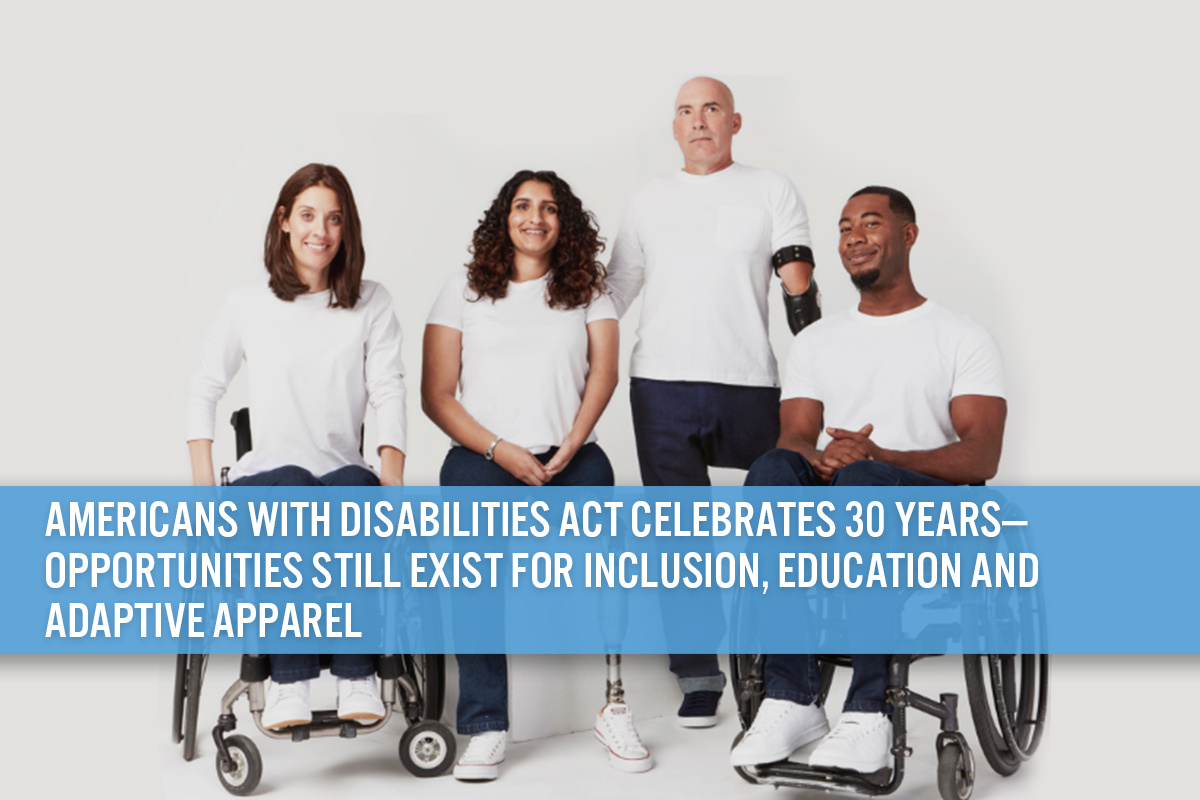
albert Chan
What’s the Story?
The ADA, which became law in July 1990, is a civil rights law that prohibits discrimination based on disability—affording protection to people with disabilities in terms of quality of life and access to work, health, social and leisure opportunities without discrimination.
Following the 30-year anniversary of the ADA, we look at how inclusion for people with disabilities is being realized in the US and the role that adaptive apparel can play in facilitating this. We discuss the opportunity that we see for brands and retailers to enter the adaptive apparel and footwear market and develop innovations to serve the community.
Why It Matters
Individuals with disabilities still experience challenges related to financial inclusion that extend to poverty and underemployment. Systematic improvements towards financial empowerment will help not only people with disabilities but the caregivers, family and community around them.
This is a pressing issue in the US for a number of reasons:
- Around one in eight individuals in the US reports living with a disability, according to the US Census Bureau.
- Poverty rates among people with disabilities range from 12.5% to 37.4% across four major cities, as presented by Empowered Cities (which we discuss later).
- Underemployment rates among people with disabilities in those four cities ranges between 56% and 78%, according to the same presentation.
Adaptive apparel can play a part in facilitating economic inclusion for all. We see an opportunity for brands and retailers to enter, and innovate in, the adaptive apparel and footwear market.
- Furthermore, adaptive retail extends beyond catering for disabilities; it can also offer solutions to alleviate temporary or chronic health conditions. For example, individuals that need hip replacements can benefit from adaptive apparel solutions.
- Amid the Covid-19 crisis, adaptive apparel companies have been expanding their missions to serve the health-care community and community at large as trusted partners.
Opportunities for Inclusion, Education and Adaptive Apparel
1. Empowered Cities Works Toward Financial Empowerment for People with DisabilitiesEmpowered Cities is an initiative that engages with the disability community across the US to expand financial empowerment and inclusion for people with disabilities. With guidance from the National Disability Institute and other partners, Empowered Cities is leading a “Roadmap to Economic Inclusion” in 2020 across the US. The roadmap includes an analysis of existing capacity, assets and gaps across housing, employment and financial empowerment for people with disabilities—and will recommend opportunities and solutions that each municipality can lead. In addition, program collaborators will also organize and participate in national convenings to share best practices and inform policy and advocacy efforts.
In addition to the roadmap, Empowered Cities is engaging in partnerships across multiple cities in the US—including Boston, Chicago, Los Angeles, New York City, Portland and San Francisco—led by the New York City Mayor’s Office for People with Disabilities. The organization recently hosted representatives from these cities in webinars that presented information on each city’s disability community and the challenges they face; we summarize the disability communities of selected cities in Figure 1.
- The presentation showed that the disability population across four cities ranged from 10% to 12.8%.
- Underemployment of people with disabilities represents one of the biggest challenges, with percentages ranging between 56% and 78%.
- Poverty among people with disabilities ranges from 12.5% in Boston to 37.4% in New York City.
Figure 1. Populations of People with Disabilities: Boston, Los Angeles, New York City and Portland
[wpdatatable id=367]*Data for Los Angeles presented as households Source: Empowered Cities, July 2020
2. Covid-19 Puts a Spotlight on Industry Needs; Adaptive Apparel Companies Expand Their Missions To Serve the CommunityThe “Empowered Cities Task Force,” which comprises representatives from the partner cities, highlighted during the webinars that needs vary throughout the US in terms of employment, housing, food, PPE for Covid-19 and access to digital equipment and facilities.
Across the Empowered Cities presentations, the digital divide was highlighted as one of the biggest challenges facing the disability community—which develops when people do not have access to computer technology, Internet services or proper computer training. Furthermore, Covid-19 prompted many daily activities to move online—from work to medical appointments—exacerbating the challenges faced by people with disabilities. Each task force member highlighted the need for technology resources and training that are tailored for the disability community.
Employment access is another key focus area for the initiative. Nicole Bohn, the Empowered Cities Task Force Representative for San Francisco, stated that working only in dedicated organizations for people with disabilities is not the answer—adding that when employees with disabilities are given the resources they need in any organization, they can flourish. The task force members discussed the benefits of inclusion and diversity in the workforce, and how employment opportunities have been one of the steepest challenges for disability populations nationwide.
[caption id="attachment_114018" align="aligncenter" width="550"]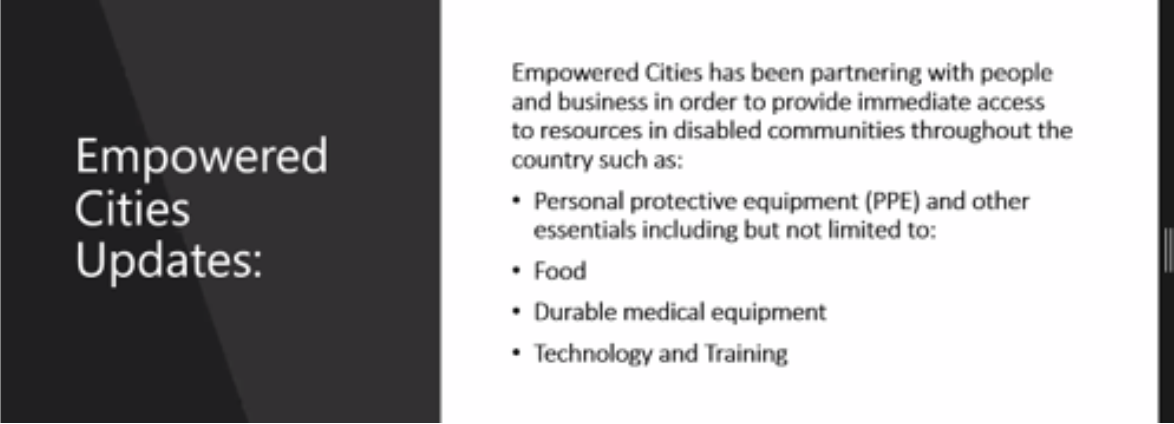 Source: Empowered Cities, July 2020[/caption]
Source: Empowered Cities, July 2020[/caption]
Below, we highlight two adaptive apparel companies that expanded their product offerings to cater for needs arising from the Covid-19 pandemic.
IZ Adaptive is a Canada-based brand that offers fashionable and functional adaptive apparel in the men’s, women’s and unisex apparel categories. The brand features tops, bottoms, jackets, coats and underwear, with sizes in the range XS–3XL. The collection aims to make getting dressed easier for everyone, while bringing more independence to people with disabilities. Founder Izzy Camilleri, made the shift from runway to couture in 2009 after she custom-designed an outfit for a quadriplegic client.
- During Covid-19, the company expanded its mission to produce protective masks in eco-friendly fabric. For every mask purchased, it donates a mask to a hospital in need.
- Camilleri also designed a lip-reader mask to support individuals who are hearing impaired, which feature a clear panel to show the mouth of the speaker in the mask. For every mask sold in Canada, the company donates 20% of the sale to the Canadian Hearing Services. This is an example of adaptive apparel that is not simply worn by the person with a disability, but focuses on inclusion by engaging a wider consumer base.
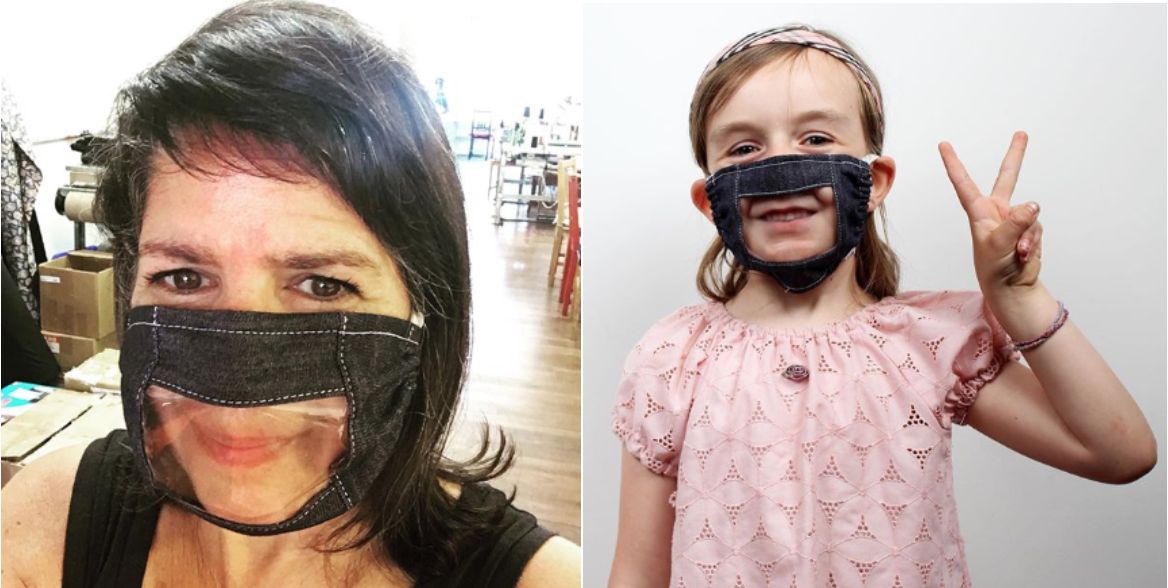 IZ Adaptive Founder Izzy Camilleri wearing the lip-reader mask (left); The lip-reader mask (right)
IZ Adaptive Founder Izzy Camilleri wearing the lip-reader mask (left); The lip-reader mask (right)Source: IZadaptive Instagram[/caption]
improve people’s health experiences as they receive various medical treatments. The company’s products include antimicrobial arm covers for PICC lines and apparel with accessible zippers for port lines.
- Care+Wear expanded its mission and adaptive services during Covid-19 to provide PPE to the industry and source masks, gowns, gloves, face shields, goggles and shoe covers.
- Care+Wear was recognized by New York Congresswoman Maloney for its contributions to supplying the health-care industry in a press release dated May 28, 2020. Care+Wear was thanked for producing PPE for the front lines. As part of that release, the company’s Co-Founder and CEO Chaitenya Razdan stated, “A few months ago, a few of our hospital partners reached out, desperate to find reliable PPE to help protect their staff risking their lives on the front lines. In collaboration with our suppliers and local designers such as Mi Jong Lee, we have been able to provide millions of units of PPE to help hospitals and governments all over the USA. We have been proud to work collaboratively with so many great factories and companies and are looking forward to continuing the great work to protect the amazing patients and clinicians each and every day.”
The company has stated that its mission is to help every person to feel like themselves, to provide inspiration and support in time of need and to let people know that they are not alone. Among the adaptive apparel products in its collection, Care+Wear offers an NICU (natal intensive care unit) Preemie Bodysuit in collaboration with nonprofit organization March of Dimes. The innovative bodysuit includes ties and snap openings that help the baby to stay connected to essential devices without disturbance.
[caption id="attachment_114020" align="aligncenter" width="450"]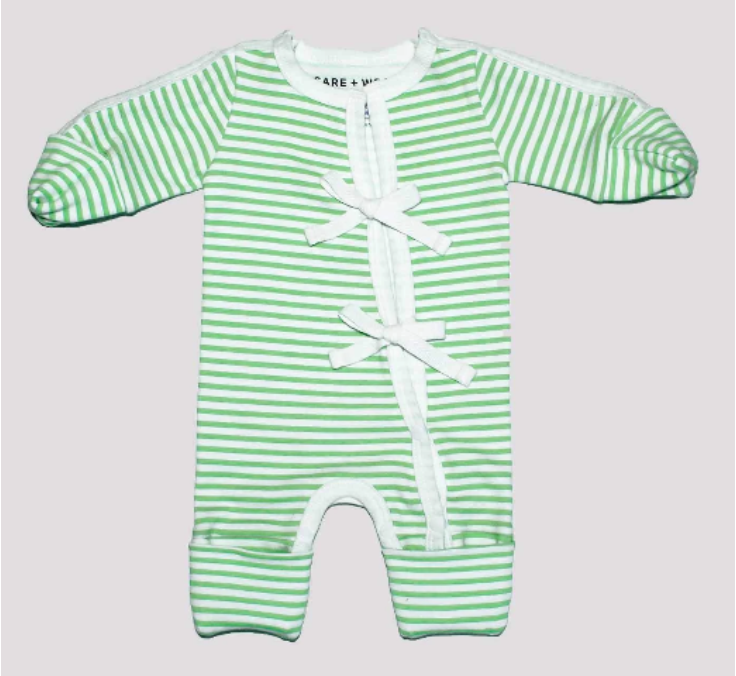 NICU Preemie Bodysuit by Care+Wear x March of Dimes
NICU Preemie Bodysuit by Care+Wear x March of DimesSource: Care+Wear[/caption] 3. Opportunities for Innovation in the Adaptive Apparel and Footwear Market
In an upcoming report, we will take an in-depth look at opportunities in the adaptive clothing and footwear market, as well as discussing leading brands and retailers in this space, which are helping to solve needs that are not met by traditional retailers. Adaptive apparel and footwear retailers may help to serve the 12.6% of consumers that self-identify as having a disability (according to Census Bureau statistics from 2018)—and also help to provide relief for individuals that suffer from temporary or chronic illnesses, such as cancer or diabetes.
Major retailers including Gap, NIKE, Target, Tommy Hilfiger and Zappos have all made inroads in the adaptive apparel and footwear market over the past 10 years. However, the market continues to be underserved, with few new market entrants and just a handful of major players. Therefore, there is an opportunity for brands and retailers to innovate and enter into this market to meet demand for fashionable and functional adaptive apparel products.
4. How Organizations Can Help the Disabled CommunityEducation, resources and employment/inclusion are the three main ways that Empowered Cities highlights for organizations to best help the disability community.
[caption id="attachment_114021" align="aligncenter" width="550"]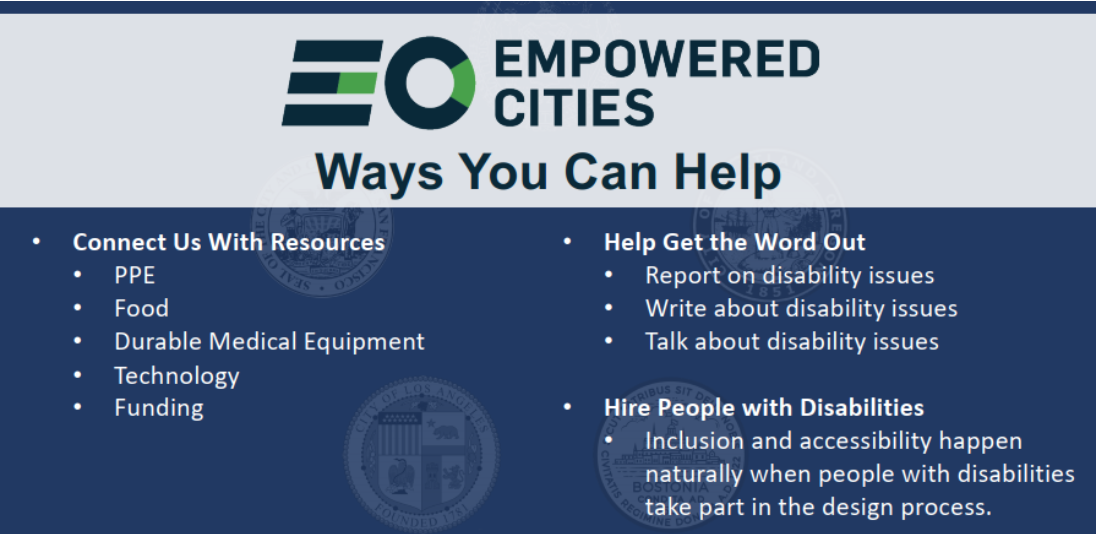 Source: Empowered Cities, July 2020[/caption]
Source: Empowered Cities, July 2020[/caption]
Key Insights
Although the ADA became law 30 years ago, the disability community still faces challenges. We see an opportunity for brands and retailers to engage with this community and leverage opportunities in the adaptive apparel and footwear market—with a target market of the 12.6% of US consumers that self-identify as having a disability, according to the Census Bureau. Furthermore, as can be seen with the example of IZ Adaptive’s lip-reader mask, solutions that help people with disabilities may be targeted at broader consumer bases. Adaptive apparel also extends to serving individuals that suffer from temporary or chronic illness, such as cancer or diabetes.
- Adaptive apparel brands IZ Adaptive and Care+Wear extended their missions beyond adaptive apparel to serve the health-care industry during Covid-19. Both companies cited that their relationships as trusted partners within the health-care community helped them to expand their mission so successfully.
- Empowered Cities is building a roadmap to identify and empower the disability community across the US. Empowered Cities Task Force members determined that the digital divide and employment access are two of the most pressing issues facing the disability communities today, and the initiative emphasizes that organizations can support people with disabilities by offering employment access. Having a more diverse workforce helps employers too, because it brings in different skills, experiences and points of view into a team.
- If organizations are seeking to help the disabled community, education, resources and employment access are key, according to Empowered Cities.
This report is a precursor to Coresight Research’s upcoming deep dive into adaptive apparel, in which we will estimate the potential size of the US market and take a close look at the adaptive apparel and footwear brands and retailers that are leading the way, as well as selected organizations that are offering services for the disability community.